-

新人教版高中英语选修2Unit 1 Science and Scientists-Discovering useful structures教学设计
The grammatical structure of this unit is predicative clause. Like object clause and subject clause, predicative clause is one of Nominal Clauses. The leading words of predicative clauses are that, what, how, what, where, as if, because, etc.The design of teaching activities aims to guide students to perceive the structural features of predicative clauses and think about their ideographic functions. Beyond that, students should be guided to use this grammar in the context apporpriately and flexibly.1. Enable the Ss to master the usage of the predicative clauses in this unit.2. Enable the Ss to use the predicative patterns flexibly.3. Train the Ss to apply some skills by doing the relevant exercises.1.Guide students to perceive the structural features of predicative clauses and think about their ideographic functions.2.Strengthen students' ability of using predicative clauses in context, but also cultivate their ability of text analysis and logical reasoning competence.Step1: Underline all the examples in the reading passage, where noun clauses are used as the predicative. Then state their meaning and functions.1) One theory was that bad air caused the disease.2) Another theory was that cholera was caused by an infection from germs in food or water.3) The truth was that the water from the Broad Street had been infected by waste.Sum up the rules of grammar:1. 以上黑体部分在句中作表语。2. 句1、2、3中的that在从句中不作成分,只起连接作用。 Step2: Review the basic components of predicative clauses1.Definition

新人教版高中英语选修2Unit 1 Science and Scientists-Learning about Language教学设计
Step 7: complete the discourse according to the grammar rules.Cholera used to be one of the most 1.__________ (fear) diseases in the world. In the early 19th century, _2_________ an outbreak of cholera hit Europe, millions of people died. But neither its cause, 3__________ its cure was understood. A British doctor, John Snow, wanted to solve the problem and he knew that cholera would not be controlled _4_________ its cause was found. In general, there were two contradictory theories 5 __________ explained how cholera spread. The first suggested that bad air caused the disease. The second was that cholera was caused by an _6_________(infect) from germs in food or water. John Snow thought that the second theory was correct but he needed proof. So when another outbreak of cholera hit London in 1854, he began to investigate. Later, with all the evidence he _7_________ (gather), John Snow was able to announce that the pump water carried cholera germs. Therefore, he had the handle of the pump _8_________ (remove) so that it couldn't be used. Through his intervention,the disease was stopped in its tracks. What is more, John Snow found that some companies sold water from the River Thames that __9__________________ (pollute) by raw waste. The people who drank this water were much more likely _10_________ (get) cholera than those who drank pure or boiled water. Through John Snow's efforts, the _11_________ (threaten) of cholera around the world saw a substantial increase. Keys: 1.feared 2.when 3. nor 4.unless 5.that/which 6.infection 7.had gathered 8.removed 9.was polluted 10.to get 11. threat

新人教版高中英语选修2Unit 1 Science and Scientists-Reading and thinking教学设计
Step 5: After learning the text, discuss with your peers about the following questions:1.John Snow believed Idea 2 was right. How did he finally prove it?2. Do you think John Snow would have solved this problem without the map?3. Cholera is a 19th century disease. What disease do you think is similar to cholera today?SARS and Covid-19 because they are both deadly and fatally infectious, have an unknown cause and need serious public health care to solve them urgently.keys:1. John Snow finally proved his idea because he found an outbreak that was clearly related to cholera, collected information and was able to tie cases outside the area to the polluted water.2. No. The map helped John Snow organize his ideas. He was able to identify those households that had had many deaths and check their water-drinking habits. He identified those houses that had had no deaths and surveyed their drinking habits. The evidence clearly pointed to the polluted water being the cause.3. SARS and Covid-19 because they are both deadly and fatally infectious, have an unknown cause and need serious public health care to solve them urgently.Step 6: Consolidate what you have learned by filling in the blanks:John Snow was a well-known _1___ in London in the _2__ century. He wanted to find the _3_____ of cholera in order to help people ___4_____ it. In 1854 when a cholera __5__ London, he began to gather information. He ___6__ on a map ___7___ all the dead people had lived and he found that many people who had ___8____ (drink) the dirty water from the __9____ died. So he decided that the polluted water ___10____ cholera. He suggested that the ___11__ of all water supplies should be _12______ and new methods of dealing with ____13___ water be found. Finally, “King Cholera” was __14_____.Keys: 1. doctor 2. 19th 3.cause 4.infected with 5.hit 6.marked 7.where 8.drunk 9.pump 10.carried 11.source 12.examined 13.polluted 14.defeatedHomework: Retell the text after class and preview its language points

新人教版高中英语选修2Unit 1 Science and Scientists-Using langauge教学设计
This happens because the dish soap molecules have a strong negative charge, and the milk molecules have a strong positive charge. Like magnets, these molecules are attracted to each other, and so they appear to move around on the plate, taking the food coloring with them, making it look like the colors are quickly moving to escape from the soap.Listening text:? Judy: Oh, I'm so sorry that you were ill and couldn't come with us on our field trip. How are you feeling now? Better?? Bill: Much better, thanks. But how was it?? Judy: Wonderful! I especially liked an area of the museum called Light Games.it was really cool. They had a hall of mirrors where I could see myself reflected thousands of times!? Bill: A hall of mirrors can be a lot of fun. What else did they have?? Judy: Well, they had an experiment where we looked at a blue screen for a while, and then suddenly we could see tiny bright lights moving around on it. You'll never guess what those bright lights were!? Bill: Come on, tell me!? Judy: They were our own blood cells. For some reason, our eyes play tricks on us when we look at a blue screen, and we can see our own blood cells moving around like little lights! But there was another thing I liked better. I stood in front of a white light, and it cast different shadows of me in every color of the rainbow!? Bill: Oh, I wish I had been there. Tell me more!? Judy: Well, they had another area for sound. They had a giant piano keyboard that you could use your feet to play. But then, instead of playing the sounds of a piano, it played the voices of classical singers! Then they had a giant dish, and when you spoke into it, it reflected the sound back and made it louder. You could use it to speak in a whisper to someone 17 meters away.? Bill: It all sounds so cool. I wish I could have gone with you? Judy: I know, but we can go together this weekend. I'd love to go there again!? Bill: That sounds like a great idea!

新人教版高中英语选修2Unit 2 Bridging Cultures-Discovering useful structures教学设计
The grammar of this unit is designed to review noun clauses. Sentences that use nouns in a sentence are called noun clauses. Nominal clauses can act as subject, object, predicate, appositive and other components in compound sentences. According to the above-mentioned different grammatical functions, nominal clauses are divided into subject clause, object clause, predicate clause and appositive clause. In this unit, we will review the three kinds of nominal clauses. Appositive clauses are not required to be mastered in the optional compulsory stage, so they are not involved.1. Guide the students to judge the compound sentences and determine the composition of the clauses in the sentence.2. Instruct students to try to learn grammar by generalizing grammar rules, controlling written practice, and semi-open oral output.3. Inspire the students to systematize the function and usage of noun clause1.Instruct students to try to learn grammar by generalizing grammar rules, controlling written practice, and semi-open oral output.2.Inspire the students to systematize the function and usage of noun clauseStep1: The teacher ask studetns to find out more nominal clauses from the reading passage and udnerline the nominal clauses.

新人教版高中英语选修2Unit 3 Food and Culture-Discovering useful structures教学设计
The newspaper reported more than 100 people had been killed in the thunderstorm.报纸报道说有一百多人在暴风雨中丧生。(2)before、when、by the time、until、after、once等引导的时间状语从句的谓语是一般过去时,以及by、before后面接过去的时间时,主句动作发生在从句的动作或过去的时间之前且表示被动时,要用过去完成时的被动语态。By the time my brother was 10, he had been sent to Italy.我弟弟10岁前就已经被送到意大利了。Tons of rice had been produced by the end of last month. 到上月底已生产了好几吨大米。(3) It was the first/second/last ... time that ...句中that引导的定语从句中,主语与谓语构成被动关系时,要用过去完成时的被动语态。It was the first time that I had seen the night fact to face in one and a half years. 这是我一年半以来第一次亲眼目睹夜晚的景色。(4)在虚拟语气中,条件句表示与过去事实相反,且主语与谓语构成被动关系时,要用过去完成时的被动语态。If I had been instructed by him earlier, I would have finished the task.如果我早一点得到他的指示,我早就完成这项任务了。If I had hurried, I wouldn't have missed the train.如果我快点的话,我就不会误了火车。If you had been at the party, you would have met him. 如果你去了晚会,你就会见到他的。

新人教版高中英语选修2Unit 5 First Aid-Discovering useful structures教学设计
You have no excuse for not going.你没有理由不去。He was punished for not having finished his homework.他因未完成作业而受到惩罚。2.动词ing形式复合结构由物主代词或人称代词宾格、名词所有格或普通格加动词ing,即“sb./sb.'s+doing”构成。动词ing形式的复合结构实际上是给动词ing形式加了一个逻辑主语。动词ing形式的复合结构有四种形式:①形容词性物主代词+动词ing②名词所有格+动词ing③代词宾格+动词ing④名词+动词ingHer coming to help encouraged all of us.她来帮忙鼓舞了我们所有人。The baby was made awake by the door suddenly shutting.这个婴儿被突然的关门声吵醒了。Can you imagine him/Jack cooking at home?你能想象他/杰克在家做饭的样子吗?无生命名词无论是作主语还是作宾语都不能用第②种形式。Tom's winning first prize last year impressed me a lot.汤姆去年得了一等奖使我印象深刻。Do you mind my/me/Jack's/Jack leaving now?你介意我/杰克现在离开吗?Excuse me for my not coming on time.很抱歉我没能按时来。His father's being ill made him worried.他父亲病了,他很担心。We are looking forward to the singer's/the singer to give us a concert.我们盼望着这位歌手来给我们举办一场演唱会。
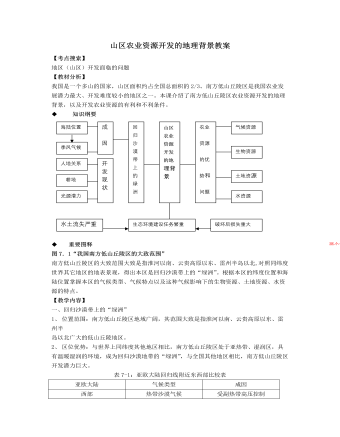
人教版高中地理选修2山区农业资源开发的地理背景教案
图7.1“我国南方低山丘陵区的大致范围”南方低山丘陵区的大致范围大致是指淮河以南、云贵高原以东、雷州半岛以北,对照同纬度世界其它地区的地表景观,得出本区是回归沙漠带上的“绿洲”。根据本区的纬度位置和海陆位置掌握本区的气候类型、气候特点以及这种气候影响下的生物资源、土地资源、水资源的特点。【教学内容】一、回归沙漠带上的“绿洲”1、 位置范围:南方低山丘陵区地域广阔,其范围大致是指淮河以南、云贵高原以东、雷州半岛以北广大的低山丘陵地区。2、 区位优势:与世界上同纬度其他地区相比,南方低山丘陵区处于亚热带、湿润区,具有温暖湿润的环境,成为回归沙漠地带的“绿洲”,与全国其他地区相比,南方低山丘陵区开发潜力巨大。
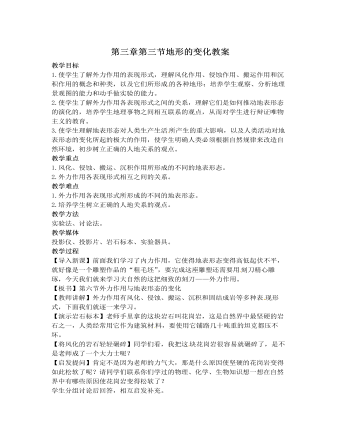
人教版高中地理选修1第三章第三节地形的变化教案
在自然界也是如此,可以看到砾石、沙、粉砂、粘土等颗粒大小不同的沉积物。【出示投影片提问】(河流下游三角洲示意图)这是一幅河流下游三角洲的示意图,你能用沉积作用的原理来解释它的形成过程吗?学生讨论、回答。【教师小结】河流携带着大量的泥沙,到达下游时由于流速降低,泥沙大量沉积,常常会形成宽广平坦的三角洲和冲积平原。在那里土壤肥沃,灌溉便利,通常是良好的农业区。【转折过渡】流水的沉积作用给人类带来了肥沃的冲积平原,风力的沉积作用给人类又带来了什么呢?【分析讲解】在沙漠中有大量的沙丘,这些沙丘在风力作用下会成为流动沙丘,掩没农田和村庄,甚至是整个城市。人类正在探索控制沙漠扩展的方法。【转折过渡】沉积物经过物理的、化学的以及生物化学的变化和改造,又会重新变成坚硬的岩石,这种作用叫做团结成岩作用。
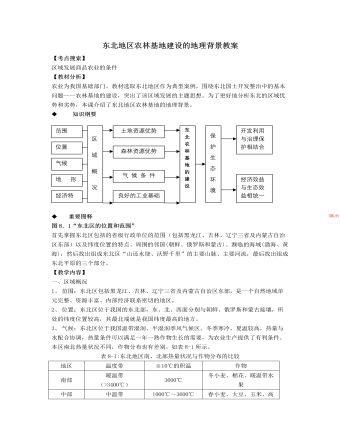
人教版高中地理选修2东北地区农林基地建设的地理背景教案
图8.1“东北区的位置和范围”首先掌握东北区包括的省级行政单位的范围(包括黑龙江、吉林、辽宁三省及内蒙古自治区东部)以及纬度位置的特点、周围的邻国(朝鲜、俄罗斯和蒙古)、濒临的海域(渤海、黄海),然后找出组成东北区“山还水绕、沃野千里”的主要山脉、主要河流,最后找出组成东北平原的三个部分。【教学内容】一、区域概况1、 范围:东北区包括黑龙江、吉林、辽宁三省及内蒙古自治区东部,是一个自然地域单元完整、资源丰富、内部经济联系密切的地区。2、 位置:东北区位于我国的东北部,东、北、西面分别与朝鲜、俄罗斯和蒙古接壤,所处的纬度位置较高,其最北端就是我国纬度最高的地方。3、 气候:东北区位于我国温带湿润、半湿润季风气候区。冬季寒冷,夏温较高,热量与水配合协调,热量条件可以满足一年一熟作物生长的需要,为农业生产提供了有利条件。本区南北热量状况不同,作物分布也有差别。如表8-1所示。
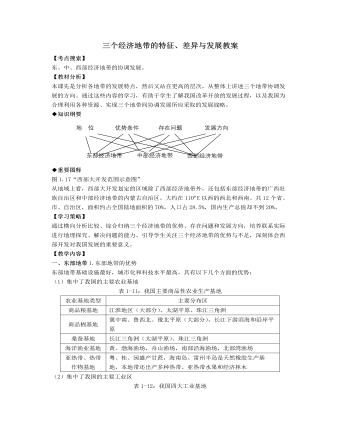
人教版高中地理选修2三个经济地带的特征、差异与发展教案
4、在西部大开发中,铁路等基础设施必须先行。这主要是因为铁路建设()A.投资规模巨大,建设周期长B.提供就业机会,提高人均收入C.加快商品流通,促进共同发展D.投资回报较高,实现持续发展5、根据我国三个经济地带的发展理论,西部经济地带将建成()A.水电基地B.商品粮基地C.有色金属等原材料基地D.石油和畜牧业基地6、对三个经济地带协调发展的理解,正确的是()A.地区间的协调发展,应逐渐缩小各地带的经济差距或使扩大的趋势有所缓解B.产业间的协调发展,形成合理的地区产业结构和产业特色C.优势互补,合理分工,平均发展D.把中西部的资源优势转化为经济优势,全部就地加工石油和天然气资源7、下列有关三个经济地带发展的叙述,正确的是()A.把部分劳动密集型加工企业逐步转移到中西部B.把农牧产品加工企业逐步转移到东部C.优先安排东部地区基础设施和资源开发项目D.充分发挥三个地带各自的优势,实现协调发展
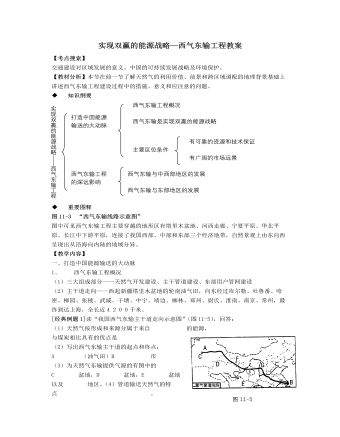
人教版高中地理选修2实现双赢的能源战略—西气东输工程教案
图11-3 “西气东输线路示意图”图中可见西气东输工程主要穿越的地形区有塔里木盆地、河西走廊、宁夏平原、华北平原、长江中下游平原,连接了我国西部、中部和东部三个经济地带,自然景观上由东向西呈现出从沿海向内陆的地域分异。【教学内容】一、 打造中国能源输送的大动脉1、 西气东输工程概况(1)三大组成部分——天然气开发建设、主干管道建设、东部用户管网建设(2)主干道走向——西起新疆塔里木盆地的轮南油气田,向东经过库尔勒、吐鲁番、哈密、柳园、张掖、武威、干塘、中宁、靖边、柳林、郑州、尉氏、淮南、南京、常州,最终到达上海,全长近4200千米。[经典例题1]读“我国西气东输主干道走向示意图”(图11-5),回答:(1)天然气按形成和来源分属于来自 的能源,与煤炭相比具有的优点是
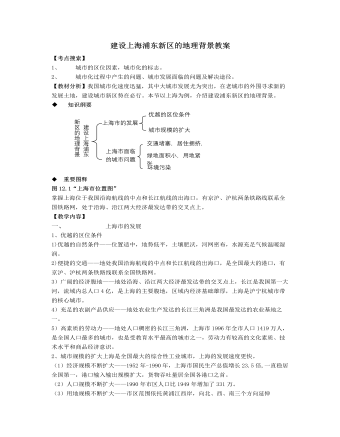
人教版高中地理选修2建设上海浦东新区的地理背景教案
2、上海是全国最大的商业中心,上海港是全国最大的港口。商业中心区位选择因素与港口的区位选择因素的共性条件是( )A、自然地理条件B、经济地理条件C、地理位置D、经济腹地3、中国政府宣布开发上海浦东的时间是( )A、1978年B、1985年C、1989年D、1990年4、有关上海优越区位条件的叙述,错误的是( )A、长江三角洲可提供充足的农副产品B、是全国最大的交通枢纽C、是我国最大城市带的核心城市D、是我国面积最大的直辖市5、目前上海市面临的最主要的人口问题是( )A、人口老龄化,青壮年赡养照顾众多老人负担过重B、卫星城镇人口比重大C、人口基数大,自然增长率高D、人口年龄构成轻,生育高峰压力大6、城市问题产生的主要原因是( )A、城市规模扩大B、城市基础设施相对滞后C、城市管理混乱D、城市人口规模和经济规模的迅速扩大7、下列可反映上海市的城市问题的是( )A、上海市区人均道路面积略高于北京市区B、上海市沙尘暴天气多发C、上海市许多家庭三代人同室居住D、上海市人均绿地面积稍高于重庆
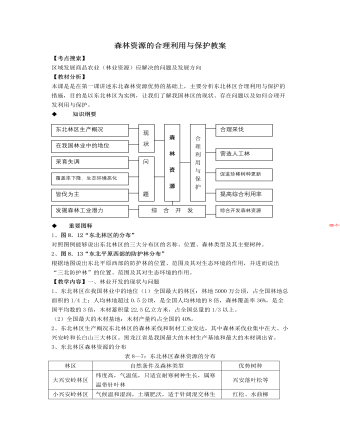
人教版高中地理选修2森林资源的合理利用与保护教案
1、图8.12“东北林区的分布”对照图例能够说出东北林区的三大分布区的名称、位置、森林类型及其主要树种。2、图8.13“东北平原西部的防护林分布”根据地图说出东北平原西部的防护林的位置、范围及其对生态环境的作用,并进而说出“三北防护林”的位置、范围及其对生态环境的作用。【教学内容】一、林业开发的现状与问题1、东北林区在我国林业中的地位(1)全国最大的林区:林地5000万公顷,占全国林地总面积的1/4上;人均林地超过0.5公顷,是全国人均林地的8倍,森林覆盖率36%,是全国平均数的3倍,木材蓄积量22.5亿立方米,占全国总量的1/3以上。(2)全国最大的木材基地:木材产量约占全国的40%。2、东北林区生产概况东北林区的森林采伐和制材工业发达,其中森林采伐业集中在大、小兴安岭和长白山三大林区。黑龙江省是我国最大的木材生产基地和最大的木材调出省。3、东北林区森林资源的分布
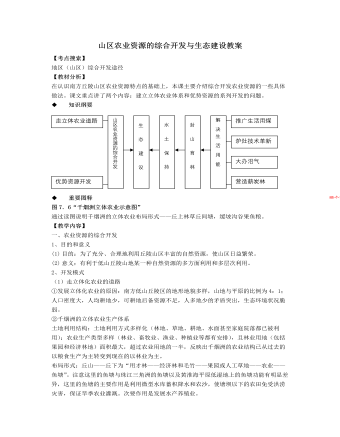
人教版高中地理选修2山区农业资源的综合开发与生态建设教案
【教学内容】一、农业资源的综合开发1、目的和意义(1) 目的:为了充分、合理地利用丘陵山区丰富的自然资源,使山区日益繁荣。(2) 意义:有利于低山丘陵山地某一种自然资源的多方面利用和多层次利用。2、开发模式(1)走立体化农业的道路①发展立体化农业的原因:南方低山丘陵区的地形地貌多样,山地与平原的比例为4:1;人口密度大,人均耕地少,可耕地后备资源不足,人多地少的矛盾突出,生态环境状况脆弱。②千烟洲的立体农业生产体系土地利用结构:土地利用方式多样化(林地、草地、耕地、水面甚至家庭院落都已被利用);农业生产类型多样(林业、畜牧业、渔业、种植业等都有安排),且林业用地(包括果园和经济林地)面积最大,超过农业用地的一半,反映出千烟洲的农业结构已从过去的以粮食生产为主转变到现在的以林业为主。布局形式:丘山——丘下为“用才林——经济林和毛竹——果园或人工草地——农业——鱼塘”。
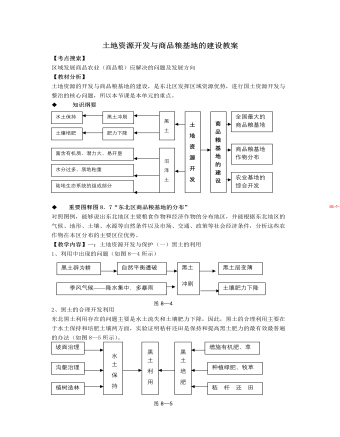
人教版高中地理选修2土地资源开发与商品粮基地的建设教案
3、东北区商品粮基地的建设松嫩平原和三江平原是我国最重要的商品粮基地,三江平原所能够提供的商品粮比重在全国最大,而且开发历史短、地广人稀、土地资源丰富、具有较大的开发潜力。4、东北区商品粮基地的综合开发东北区农业基地的综合开发,就是要在不断提高种植业本身生产潜力的基础上,大力发展养殖业和农产品加工业,使农产品多层次大幅度升值。总结:搞好商品粮基地和林业基地建设,必须从改善农业生态环境出发,坚持开发和利用、治理和保护相结合,坚持经济效益、生态效益相统一。这就要求不能通过大幅度开垦荒地、增加耕地面积来发展粮食生产,发挥现有耕地的生产潜力,提高单产是今后实现粮食增产的根本途径。【知能训练】一、选择题(第1-4题为单项选择题,第5-6题为双项选择题)1、保护和提高黑土肥力最有效的办法是 ( )A、秸秆还田B、增施化肥C、植树造林D、焚烧秸秆

人教版高中地理选修2西南区交通运输建设与区域经济发展教案
1、图9.6“南昆铁路示意图”掌握南昆铁路起止点、支线、途经地区、铁路线附近的矿产资源(云南的磷矿、贵州的煤矿、广西的铝矿等);南昆铁路使西南区南连北海、防城港、湛江、钦州等港,成为西南区通往沿海地区最便捷的出海通道,使西南地区物资出海路程缩短了600千米,对西南区的发展具有十分重要的经济、政治、战略意义。2、图9.10“西南三省一市和广西主要铁路分布图”本图展现了西南三省一市和广西的主要铁路分布,要求重点掌握本区内的环状铁路——成渝-川黔-贵昆-成昆线,新建的南昆线、内昆线,以及宝成线(联系西北区),襄渝线、湘黔线和湘桂-黔桂线(联系中南区),枝柳线(联系中南区和华北区)等区际铁路,昆河线等国际铁路及重要铁路枢纽。3、图9.11“西藏自治区交通图”西藏自治区是我国目前唯一没有正式通铁路的省级行政区,读图后要能掌握联系拉萨的四大入藏(川藏、青藏、新藏、滇藏)公路及正在建设的青藏铁路。

人教版高中地理选修2我国的三个经济地带教案
1、 下列四组地形中,全部属于西部大开发区域的是()A.江南丘陵——阿尔泰山——云贵高原——祁连山B.柴达木盆地——天山——江南丘陵——云贵高原C.准噶尔盆地——云贵高原——青藏高原——横断山D.塔里木盆地——云贵高原——黄土高原——太行山2、“西气东输”工程起始于()A.哈密盆地B.塔里木盆地C.柴达木盆地D.吐鲁番盆地3、 西部地区正在大力发展水电事业,其中已经建成并在最近开始向上海输送电能的水电站是()A.二滩水电站B.丹江口水电站C.龙羊峡水电站D.新安江水电站4、目前进入西藏地区主要依靠公路。下列四条进藏公路中,海拔最高的是()A.青藏公路B.川藏公路C.滇藏公路D.新藏公路5、青藏铁路将经过三江源(长江、黄河、澜沧江之源)地区。下列关于该地区地理环境特点的叙述,正确的是()A.山高坡陡,地势起伏大B.太阳辐射强,日照时间长,热量充足C.气温低,牧草矮,生态环境脆弱D.积雪冰川多,水资源和水能资源丰富
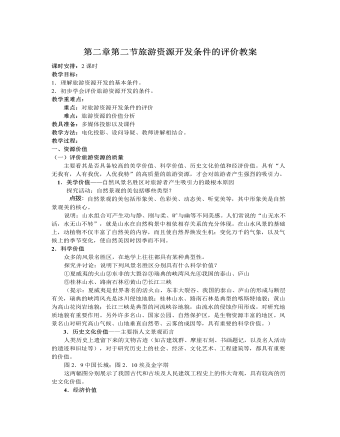
人教版高中地理选修3第二章第二节旅游资源开发条件的评价教案
案例①武夷山景区通过对案例①的学习,了解到:①武夷山景区自然景观优美,并具有较高的科学价值(丹霞地貌和生物多样性)、历史文化价值(丰富的文化遗存),具有极高的旅游资源价值。②地理位置优越和交通条件便利、基础设施完善。③武夷山的国内客源市场主要集中在长江三角洲和珠江三角洲,国际客源市场主要分布在以新加坡、日本为主的亚洲。游客多,市场广阔。通过分析,进一步了解旅游资源开发条件评价的基本内容。图2.15武夷山景区旅游略图通过图2.15了解了武夷山著名景区、景点的分布。活动根据案例,结合图2.15,试对武夷山景区的开发条件进行评价提示:可按以下步骤进行;1.根据学生各自的兴趣爱好和性格,自由组合分组。2.仔细阅读本案例,各组确定自己感兴趣的评价项目,并通过新闻媒介、网络、书籍等进一步收集有关信息。3.小组信息汇总,进行组内讨论。4.小组在全班进行汇报交流。
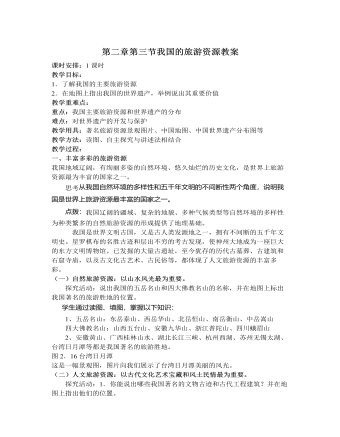
人教版高中地理选修3第二章第三节我国的旅游资源教案
2.对世界遗产的开发与保护原则——保护第一我国的世界文化遗产、世界文化与自然双遗产具有时代性、不可再生性和不可替代性,我国的世界自然遗产都代表着某一类地质地貌中最重要的历史演化过程,展示了我国独特的地质地貌和生物资源。世界遗产的开发与保护之间存在一定的矛盾。我们必须坚持保护第一的原则。旅游开发只是世界遗产的功用之一,必须十分慎重,做到保护与开发协调统一,不能造成对世界遗产的任何破坏。案例②我国第一个世界文化与自然双遗产——泰山通过学习案例②,了解到:①泰山不仅具有科学价值较高的地质构造,还具有多样的地貌景观,罕见的天象景观,丰富的生物资源。泰山自古以来即被誉为名山,受到皇家和百姓的顶礼膜拜,各朝各代几乎都进行过封禅行为,从而留下了深厚的历史文化遗存,这一点跟其他名山相比是独一无二的。

